国际会议学术报告格式范例
国际会议学术报告格式范例
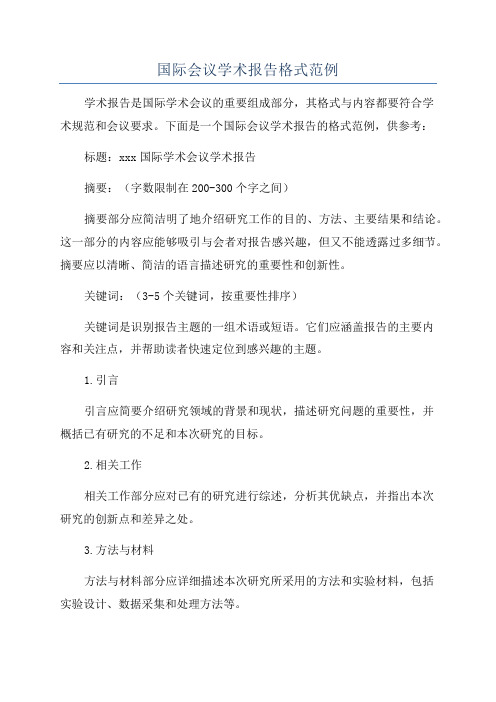
国际会议学术报告格式范例学术报告是国际学术会议的重要组成部分,其格式与内容都要符合学术规范和会议要求。
下面是一个国际会议学术报告的格式范例,供参考:标题:xxx国际学术会议学术报告摘要:(字数限制在200-300个字之间)摘要部分应简洁明了地介绍研究工作的目的、方法、主要结果和结论。
这一部分的内容应能够吸引与会者对报告感兴趣,但又不能透露过多细节。
摘要应以清晰、简洁的语言描述研究的重要性和创新性。
关键词:(3-5个关键词,按重要性排序)关键词是识别报告主题的一组术语或短语。
它们应涵盖报告的主要内容和关注点,并帮助读者快速定位到感兴趣的主题。
1.引言引言应简要介绍研究领域的背景和现状,描述研究问题的重要性,并概括已有研究的不足和本次研究的目标。
2.相关工作相关工作部分应对已有的研究进行综述,分析其优缺点,并指出本次研究的创新点和差异之处。
3.方法与材料方法与材料部分应详细描述本次研究所采用的方法和实验材料,包括实验设计、数据采集和处理方法等。
4.实验结果与分析实验结果与分析部分应精确地描述实验结果,并通过统计分析、图表和图像等形式对结果进行解读和分析。
5.讨论与结论讨论与结论部分应对实验结果进行深入分析,并与已有研究进行比较和讨论。
同时,根据实验结果,提出对未来研究的建议和展望。
7.致谢(可选)致谢部分可以感谢提供实验材料、技术支持或研究基金等方面给予帮助的个人或机构。
以上是国际会议学术报告的格式范例,报告的具体内容应根据研究或实验的不同而有所调整。
在撰写报告时,需要注意语言规范、逻辑性和严谨性,确保报告能够清晰、准确地传达研究成果和意义。
同时,注意报告时间的控制,以保证能够在规定时间内完成报告及相关问答等环节。
国际会议论文格式
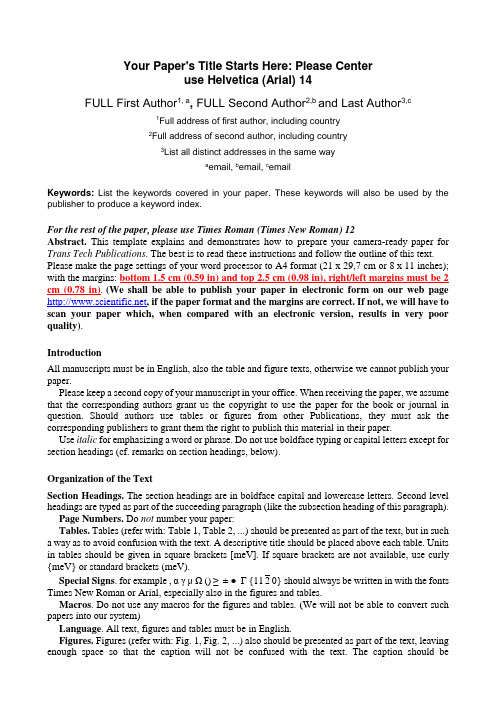
Your Paper's Title Starts Here: Please Centeruse Helvetica (Arial) 14FULL First Author1, a, FULL Second Author2,b and Last Author3,c1Full address of first author, including country2Full address of second author, including country3List all distinct addresses in the same waya email,b email,c emailKeywords:List the keywords covered in your paper. These keywords will also be used by the publisher to produce a keyword index.For the rest of the paper, please use Times Roman (Times New Roman) 12Abstract.This template explains and demonstrates how to prepare your camera-ready paper for Trans Tech Publications. The best is to read these instructions and follow the outline of this text. Please make the page settings of your word processor to A4 format (21 x 29,7 cm or 8 x 11 inches); with the margins: bottom 1.5 cm (0.59 in) and top 2.5 cm (0.98 in), right/left margins must be 2 cm (0.78 in).(We shall be able to publish your paper in electronic form on our web page , if the paper format and the margins are correct. If not, we will have to scan your paper which, when compared with an electronic version, results in very poor quality).IntroductionAll manuscripts must be in English, also the table and figure texts, otherwise we cannot publish your paper.Please keep a second copy of your manuscript in your office. When receiving the paper, we assume that the corresponding authors grant us the copyright to use the paper for the book or journal in question. Should authors use tables or figures from other Publications, they must ask the corresponding publishers to grant them the right to publish this material in their paper.Use italic for emphasizing a word or phrase. Do not use boldface typing or capital letters except for section headings (cf. remarks on section headings, below).Organization of the TextSection Headings. The section headings are in boldface capital and lowercase letters. Second level headings are typed as part of the succeeding paragraph (like the subsection heading of this paragraph).Page Numbers. Do not number your paper:Tables. Tables (refer with: Table 1, Table 2, ...) should be presented as part of the text, but in such a way as to avoid confusion with the text. A descriptive title should be placed above each table. Units in tables should be given in square brackets [meV]. If square brackets are not available, use curly {meV} or standard brackets (meV).Special Signs. for example , αγμΩ () ≥ ± ● Γ {1120}should always be written in with the fonts Times New Roman or Arial, especially also in the figures and tables.Macros. Do not use any macros for the figures and tables. (We will not be able to convert such papers into our system)Language. All text, figures and tables must be in English.Figures. Figures (refer with: Fig. 1, Fig. 2, ...) also should be presented as part of the text, leaving enough space so that the caption will not be confused with the text. The caption should beself-contained and placed below or beside the figure. Generally, only original drawings or photographic reproductions are acceptable. Only very good photocopies are acceptable. Utmost care must be taken to insert the figures in correct alignment with the text. Half-tone pictures should be in the form of glossy prints. If possible, please include your figures as graphic images in the electronic version. For best quality the pictures should have a resolution of 300 dpi(dots per inch).Color figures are welcome for the online version of the journal. Generally, these figures will be reduced to black and white for the print version.Equations. Equations (refer with: Eq. 1, Eq. 2, ...) should be indented 5 mm (0.2"). There should be one line of space above the equation and one line of space below it before the text continues. The equations have to be numbered sequentially, and the number put in parentheses at the right-hand edge of the text. Equations should be punctuated as if they were an ordinary part of the text. Punctuation appears after the equation but before the equation number, e.g.c2 = a2 + b2. (1)Literature ReferencesReferences are cited in the text just by square brackets [1]. (If square brackets are not available, slashes may be used instead, e.g. /2/.) Two or more references at a time may be put in one set of brackets [3,4]. The references are to be numbered in the order in which they are cited in the text and are to be listed at the end of the contribution under a heading References, see our example below. ConclusionsIf you follow the “c hecklist”your paper will conform to the requirements of the publisher and facilitate a problem-free publication process.AcknowledgementsThis work was financially supported by the Shanghai Natural Science Foundation (0666666), Innovation Program of Shanghai Municipal Education Commission (060000) and Shanghai Leading Academic Discipline Project of Shanghai Municipal Education Commission (0555555). References[1] Dj.M. Maric, P.F. Meier and S.K. Estreicher: Mater. Sci. Forum Vol. 83-87 (1992), p. 119[2] M.A. Green: High Efficiency Silicon Solar Cells (Trans Tech Publications, Switzerland 1987).[3] Y. Mishing, in: Diffusion Processes in Advanced Technological Materials, edtied by D. GuptaNoyes Publications/William Andrew Publising, Norwich, NY (2004), in press.[4] G. Henkelman, G.Johannesson and H. Jónsson, in: Theoretical Methods in Condencsed PhaseChemistry, edited by S.D. Schwartz, volume 5 of Progress in Theoretical Chemistry and Physics, chapter, 10, Kluwer Academic Publishers (2000).[5] R.J. Ong, J.T. Dawley and P.G. Clem: submitted to Journal of Materials Research (2003)[6] P.G. Clem, M. Rodriguez, J.A. Voigt and C.S. Ashley, U.S. Patent 6,231,666. (2001)[7] Information on 。
英文学术报告格式范文

英文学术报告格式范文Abstract.This academic report presents a comprehensive overview of the current state of research on the topic of [Topic]. The report begins by providing a brief introduction to the topic, outlining its significance and relevance to the broader field. It then delves into a detailed examination of the existing literature, discussing key findings, methodologies, and theoretical frameworks. The report also identifies gaps in the current research and suggests potential avenues for future investigation. Finally, the report concludes with a summary of the main points and highlights the implications of the research findings for theory, practice, and policy.Introduction.[Topic] is a complex and multifaceted phenomenon that has been the subject of extensive research in recent years.This report provides a comprehensive overview of the current state of research on the topic, drawing on a wide range of sources including peer-reviewed journal articles, books, and conference proceedings.Literature Review.The literature review is organized into several sections, each of which focuses on a specific aspect of the topic. The first section provides a general overview of the topic, including its definition, history, and scope. The subsequent sections discuss key findings, methodologies, and theoretical frameworks.Key Findings.The literature review reveals a number of key findings. These include:[Key Finding 1][Key Finding 2][Key Finding 3]Methodologies.A variety of methodologies have been used to study the topic. These include:[Methodology 1][Methodology 2][Methodology 3]Theoretical Frameworks.A number of theoretical frameworks have been used to explain the topic. These include:[Theoretical Framework 1][Theoretical Framework 2][Theoretical Framework 3]Gaps in the Research.The literature review also identifies a number of gaps in the current research. These include:[Gap 1][Gap 2][Gap 3]Potential Avenues for Future Investigation.The literature review suggests a number of potential avenues for future investigation. These include:[Avenue 1][Avenue 2][Avenue 3]Conclusion.This academic report has provided a comprehensive overview of the current state of research on the topic of [Topic]. The report has discussed key findings, methodologies, and theoretical frameworks, and has identified gaps in the current research. The report has also suggested a number of potential avenues for future investigation.References.The report concludes with a list of references, which includes all of the sources cited in the report.。
国际会议学术报告格式范例

结束语
• Well, this brings us to the end of my presentation. Let us see what we may conclude here.
• A promising area of future research is probably …
• Okay, this ends my presentation. Thank you for your attention. And I would be really interested in hearing your questions.
mind asking me again in the break? • So your question is … • I am not sure if there is a right or wrong answer to
your question. Personally, I think …
考试
in this table. • The last column of the table indicates close
agreement between theoretical predications and experimental results • Basically what I want to highlight in this table is …
Q&A
• Sorry, could you repeat your question more slowly please?
• Sorry, could you raise your voice a bit please? • Sorry, I still don’t get your question, would you
会议发言参考文献格式
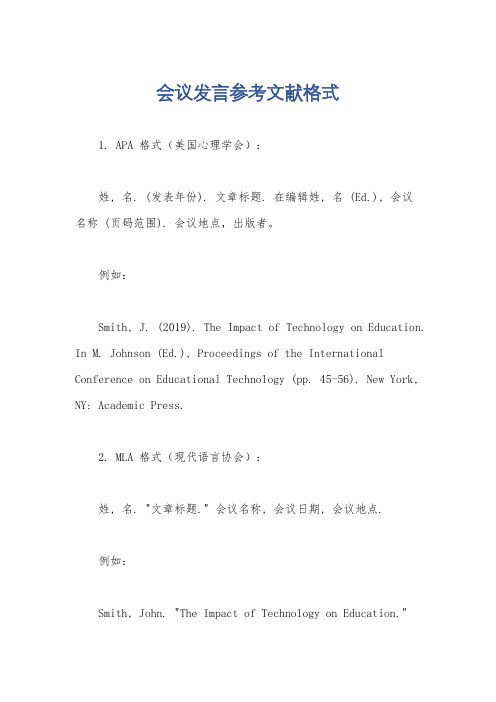
会议发言参考文献格式1. APA 格式(美国心理学会):姓, 名. (发表年份). 文章标题. 在编辑姓, 名 (Ed.), 会议名称 (页码范围). 会议地点,出版者。
例如:Smith, J. (2019). The Impact of Technology on Education. In M. Johnson (Ed.), Proceedings of the International Conference on Educational Technology (pp. 45-56). New York, NY: Academic Press.2. MLA 格式(现代语言协会):姓, 名. "文章标题." 会议名称, 会议日期, 会议地点.例如:Smith, John. "The Impact of Technology on Education."International Conference on Educational Technology, 15-17 July 2019, New York, NY.3. IEEE 格式(电气和电子工程师协会):作者. "文章标题." 会议名称, 会议日期, 页码范围.例如:J. Smith, "The Impact of Technology on Education." Proceedings of the International Conference on Educational Technology, 15-17 July 2019, pp. 45-56.请注意,以上只是常见引用规范的示例,具体的引用格式可能因学科领域、出版要求或机构规定而有所不同。
在引用会议发言时,建议您根据您所使用的引用规范或指导方针,结合具体的会议信息,进行正确的引用格式。
学术报告格式
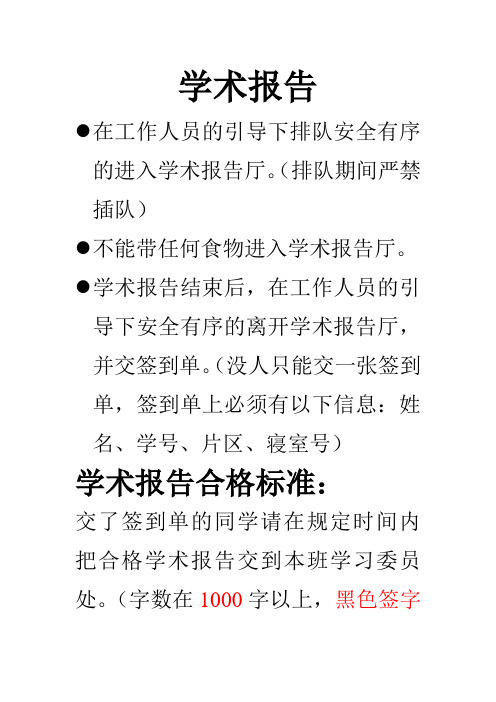
学术报告
●在工作人员的引导下排队安全有序的进入学术报告厅。
(排队期间严禁插队)
●不能带任何食物进入学术报告厅。
●学术报告结束后,在工作人员的引导下安全有序的离开学术报告厅,并交签到单。
(没人只能交一张签到单,签到单上必须有以下信息:姓名、学号、片区、寝室号)
学术报告合格标准:
交了签到单的同学请在规定时间内把合格学术报告交到本班学习委员处。
(字数在1000字以上,黑色签字
笔书写,标准信签纸,标准格式)学术报告标准格式如下:
题目:美学欣赏
主讲人:清华大学副教授xx先生
时间:2011年8月20日晚7:30—9:30 美,就是。
(内容1000字以上)
片区:A区
寝室号:A1-133
学号:40900531
姓名:土豆。
ICIEA国际会议论文格式(英文)
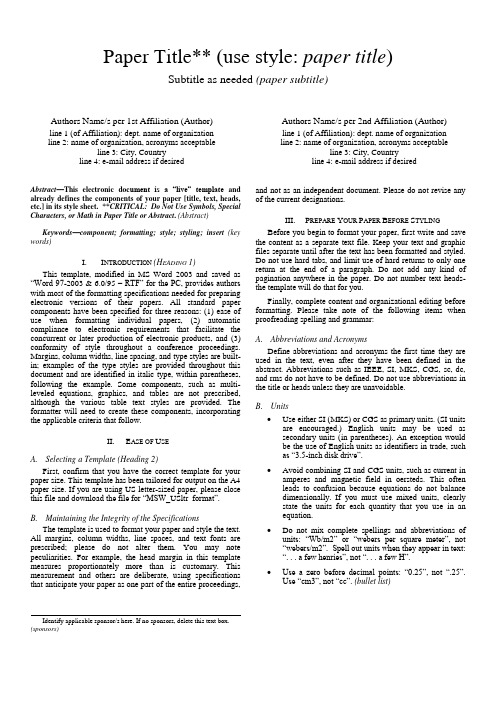
Paper Title** (use style: paper title) Subtitle as needed (paper subtitle)Authors Name/s per 1st Affiliation (Author) line 1 (of Affiliation): dept. name of organization line 2: name of organization, acronyms acceptableline 3: City, Countryline 4: e-mail address if desired Authors Name/s per 2nd Affiliation (Author) line 1 (of Affiliation): dept. name of organization line 2: name of organization, acronyms acceptableline 3: City, Countryline 4: e-mail address if desiredAbstract—This electronic doc ument is a “live” template and already defines the components of your paper [title, text, heads, etc.] in its style sheet. **CRITICAL: Do Not Use Symbols, Special Characters, or Math in Paper Title or Abstract. (Abstract) Keywords—component; formatting; style; styling; insert (key words)I.I NTRODUCTION (H EADING 1)This template, modified in MS Word 2003 and saved as ―Word 97-2003 & 6.0/95 –RTF‖ for the PC, provides authors with most of the formatting specifications needed for preparing electronic versions of their papers. All standard paper components have been specified for three reasons: (1) ease of use when formatting individual papers, (2) automatic compliance to electronic requirements that facilitate the concurrent or later production of electronic products, and (3) conformity of style throughout a conference proceedings. Margins, column widths, line spacing, and type styles are built-in; examples of the type styles are provided throughout this document and are identified in italic type, within parentheses, following the example. Some components, such as multi-leveled equations, graphics, and tables are not prescribed, although the various table text styles are provided. The formatter will need to create these components, incorporating the applicable criteria that follow.II.E ASE OF U SEA.Selecting a Template (Heading 2)First, confirm that you have the correct template for your paper size. This template has been tailored for output on the A4 paper size. If you are using US letter-sized paper, please close this file and downloa d the file for ―MSW_USltr_format‖.B.Maintaining the Integrity of the SpecificationsThe template is used to format your paper and style the text. All margins, column widths, line spaces, and text fonts are prescribed; please do not alter them. You may note peculiarities. For example, the head margin in this template measures proportionately more than is customary. This measurement and others are deliberate, using specifications that anticipate your paper as one part of the entire proceedings, and not as an independent document. Please do not revise any of the current designations.III.P REPARE Y OUR P APER B EFORE S TYLING Before you begin to format your paper, first write and save the content as a separate text file. Keep your text and graphic files separate until after the text has been formatted and styled. Do not use hard tabs, and limit use of hard returns to only one return at the end of a paragraph. Do not add any kind of pagination anywhere in the paper. Do not number text heads-the template will do that for you.Finally, complete content and organizational editing before formatting. Please take note of the following items when proofreading spelling and grammar:A.Abbreviations and AcronymsDefine abbreviations and acronyms the first time they are used in the text, even after they have been defined in the abstract. Abbreviations such as IEEE, SI, MKS, CGS, sc, dc, and rms do not have to be defined. Do not use abbreviations in the title or heads unless they are unavoidable.B.Units∙Use either SI (MKS) or CGS as primary units. (SI units are encouraged.) English units may be used assecondary units (in parentheses). An exception wouldbe the use of English units as identifiers in trade, suchas ―3.5-inch disk drive‖.∙Avoid combining SI and CGS units, such as current in amperes and magnetic field in oersteds. This oftenleads to confusion because equations do not balancedimensionally. If you must use mixed units, clearlystate the units for each quantity that you use in anequation.∙Do not mix complete spellings and abbreviations of units: ―Wb/m2‖ or ―webers per square meter‖, not―webers/m2‖. Spell out units when they appear in text:―. . . a few henries‖, not ―. . . a few H‖.∙Use a zero before decimal points: ―0.25‖, not ―.25‖.Use ―cm3‖, not ―cc‖. (bullet list)Identify applicable sponsor/s here. If no sponsors, delete this text box. (sponsors)C. EquationsThe equations are an exception to the prescribed specifications of this template. You will need to determine whether or not your equation should be typed using either the Times New Roman or the Symbol font (please no other font). To create multileveled equations, it may be necessary to treat the equation as a graphic and insert it into the text after your paper is styled.Number equations consecutively. Equation numbers, within parentheses, are to position flush right, as in (1), using a right tab stop. To make your equations more compact, you may use the solidus ( / ), the exp function, or appropriate exponents. Italicize Roman symbols for quantities and variables, but not Greek symbols. Use a long dash rather than a hyphen for a minus sign. Punctuate equations with commas or periods when they are part of a sentence, as inα + β = χ.(1)α + β = χ. (1) (1) Note that the equation is centered using a center tab stop. Be sure that the symbols in your equation have been defined before or immediately following the equation. Use ―(1)‖, not ―Eq. (1)‖ or ―equation (1)‖, except at the beginning of a sentence: ―Equation (1) is . . .‖D. Some Common Mistakes∙ Th e word ―data‖ is plural, not singular. ∙The subscript for the permeability of vacuum 0, and other common scientific constants, is zero with subscript formatting, not a lowercase letter ―o‖. ∙In American English, commas, semi-/colons, periods, question and exclamation marks are located within quotation marks only when a complete thought or name is cited, such as a title or full quotation. When quotation marks are used, instead of a bold or italic typeface, to highlight a word or phrase, punctuation should appear outside of the quotation marks. A parenthetical phrase or statement at the end of a sentence is punctuated outside of the closing parenthesis (like this). (A parenthetical sentence is punctuated within the parentheses.)∙A graph within a graph is an ―inset‖, not an ―insert‖. The word alternatively is preferred to the word ―alternately‖ (unless you really mean something that alternates).∙ Do not use the word ―essentially‖ to mean ―approximately‖ or ―effectively‖.∙In your paper title, if the words ―that uses‖ can accurately replace the word ―using‖, capitalize the ―u‖; if not, keep using lower-cased.∙Be aware of the different meanings of the homophones ―affect‖ and ―effect‖, ―complement‖ and ―compliment‖, ―discreet‖ and ―discrete‖, ―principal‖ and ―principle‖. ∙Do not confuse ―imply‖ and ―infer‖.∙ The prefix ―non‖ is not a word; it should be joined to the word it modifies, usually without a hyphen. ∙ There is no period after the ―et‖ in the Latin abbreviation ―et al.‖.∙The abbreviation ―i.e.‖ means ―that is‖, and the abbreviation ―e.g.‖ means ―for example‖.An excellent style manual for science writers is [7].IV. U SING THE T EMPLATEAfter the text edit has been completed, the paper is ready for the template. Duplicate the template file by using the Save As command, and use the naming convention prescribed by your conference for the name of your paper. In this newly created file, highlight all of the contents and import your prepared text file. You are now ready to style your paper; use the scroll down window on the left of the MS Word Formatting toolbar. A. Authors and AffiliationsThe template is designed so that author affiliations are not repeated each time for multiple authors of the same affiliation. Please keep your affiliations as succinct as possible (for example, do not differentiate among departments of the same organization). This template was designed for two affiliations. 1) For author/s of only one affiliation (Heading 3): To change the default, adjust the template as follows.a) Selection (Heading 4): Highlight all author and affiliation lines.b) Change number of columns: Select the Columns icon fro m the MS Word Standard toolbar and then select ―1 Column‖ from the selection palette.c) Deletion: Delete the author and affiliation lines for the second affiliation.d) For author/s of more than two affiliations: To change the default, adjust the template as follows.e) Selection: Highlight all author and affiliation lines. f) Change number of columns: Select the ―Columns‖ icon from the MS Word Standard toolbar and then select ―1 Column‖ from the selection palette.g) Highlight author and affiliation lines of affiliation 1 and copy this selection.h) Formatting: Insert one hard return immediately after the last character of the last affiliation line. Then paste down the copy of affiliation 1. Repeat as necessary for each additional affiliation.i) Reassign number of columns: Place your cursor to the right of the last character of the last affiliation line of an even numbered affiliation (e.g., if there are five affiliations, place your cursor at end of fourth affiliation). Drag the cursor up to highlight all of the above author and affiliation lines. Go to Column icon and select ―2 Columns‖. If you have an oddnumber of affiliations, the final affiliation will be centered on the page; all previous will be in two columns.B.Identify the HeadingsHeadings, or heads, are organizational devices that guide the reader through your paper. There are two types: component heads and text heads.Component heads identify the different components of your paper and are not topically subordinate to each other. Examples include Acknowledgments and References and, for these, the correct style to use is ―Heading 5‖. Use ―figure caption‖ foryour Figure captions, and ―table head‖ for your table title. Run-in heads, such as ―Abstract‖, will require you to apply a style (in this case, italic) in addition to the style provided by the drop down menu to differentiate the head from the text.Text heads organize the topics on a relational, hierarchical basis. For example, the paper title is the primary text head because all subsequent material relates and elaborates on this one topic. If there are two or more sub-topics, the next level head (uppercase Roman numerals) should be used and, conversely, if there are not at least two sub-topics, then no subheads should be introduced. Styles named ―Heading 1‖, ―Heading2‖, ―Heading 3‖, and ―Heading 4‖ are prescribed.C.Figures and Tables1)Positioning Figures and Tables: Place figures and tables at the top and bottom of columns. Avoid placing them in the middle of columns. Large figures and tables may span across both columns. Figure captions should be below the figures; table heads should appear above the tables. Insert figures and tables after they are cited in the text. Use the abbreviation ―Fig. 1‖, even at the beginning of a sentence.TABLE I. T ABLE T YPE S TYLESa. Sample of a Table footnote. (Table footnote)Figure Labels: Use 8 point Times New Roman for Figure labels. Use words rather than symbols or abbreviations when writing Figure axis labels to avoid confusing the reader. As an example, write the quantity ―Magnetization‖, or ―Magnetization, M‖, not just ―M‖. If including units in the label, present them within parentheses. Do not label axes only with units. In the example, write ―Magnetization (A/m)‖ or ―Magnetization {A[m(1)]}‖, not just ―A/m‖. Do not label axes with a ratio of quantities and units. For example, write ―Temperature (K)‖, not ―Temperature/K‖.A CKNOWLEDGMENT (H EADING 5)Th e preferred spelling of the word ―acknowledgment‖ in America is without an ―e‖ after the ―g‖. Avoid the stilted expression, ―One of us (R. B. G.) thanks . . .‖ Instead, try ―R.B. G. thanks‖. Put spons or acknowledgments in the unnum-bered footnote on the first page.R EFERENCESThe template will number citations consecutively within brackets [1]. The sentence punctuation follows the bracket [2]. Refer simply to the reference number, as in [3]—do not use ―Ref. [3]‖ or ―reference [3]‖ except at the beginning of a sentence: ―Reference [3] was the first . . .‖Number footnotes separately in superscripts. Place the actual footnote at the bottom of the column in which it was cited. Do not put footnotes in the reference list. Use letters for table footnotes.Unless there are six authors or more give all authors' names; do not use ―et al.‖. Papers that have not been published, even if they have been submitted for publication, should be cited as ―unpublished‖ [4]. Papers that have been accepted for publication should be cited as ―in press‖ [5]. Capitalize only the first word in a paper title, except for proper nouns and element symbols.For papers published in translation journals, please give the English citation first, followed by the original foreign-language citation [6].[1]G. Eason, B. Noble, and I. N. Sneddon, ―On certain integrals ofLipschitz-Hankel type involving products of Bessel functions,‖ Phil.Trans. Roy. Soc. London, vol. A247, pp. 529–551, April 1955.(references)[2]J. Clerk Maxwell, A Treatise on Electricity and Magnetism, 3rd ed., vol.2. Oxford: Clarendon, 1892, pp.68–73.[3]I. S. Jacobs and C. P. Bean, ―Fine particles, thin films and exchangeanisotropy,‖ in Magnetism, vol. III, G. T. Rado and H. Suhl, Eds. New York: Academic, 1963, pp. 271–350.[4]K. Elissa, ―Title of paper if known,‖ unpublished.[5]R. Nicole, ―Title of paper with only first word capitalized,‖ J. NameStand. Abbrev., in press.[6]Y. Yorozu, M. Hirano, K. Oka, and Y. Tagawa, ―Electron spectroscopystudies on magneto-optical media and plastic substr ate interface,‖ IEEE Transl. J. Magn. Japan, vol. 2, pp. 740–741, August 1987 [Digests 9th Annual Conf. Magnetics Japan, p. 301, 1982].[7]M. Young, The Technical Writer's Handbook. Mill Valley, CA:University Science, 1989.。
英文学术报告该怎么写?(含5篇)
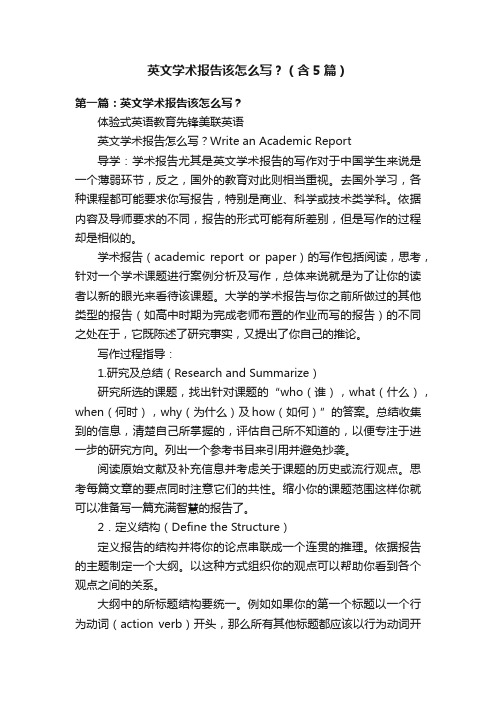
英文学术报告该怎么写?(含5篇)第一篇:英文学术报告该怎么写?体验式英语教育先锋美联英语英文学术报告怎么写?Write an Academic Report导学:学术报告尤其是英文学术报告的写作对于中国学生来说是一个薄弱环节,反之,国外的教育对此则相当重视。
去国外学习,各种课程都可能要求你写报告,特别是商业、科学或技术类学科。
依据内容及导师要求的不同,报告的形式可能有所差别,但是写作的过程却是相似的。
学术报告(academic report or paper)的写作包括阅读,思考,针对一个学术课题进行案例分析及写作,总体来说就是为了让你的读者以新的眼光来看待该课题。
大学的学术报告与你之前所做过的其他类型的报告(如高中时期为完成老师布置的作业而写的报告)的不同之处在于,它既陈述了研究事实,又提出了你自己的推论。
写作过程指导:1.研究及总结(Research and Summarize)研究所选的课题,找出针对课题的“who(谁),what(什么),when(何时),why(为什么)及how(如何)”的答案。
总结收集到的信息,清楚自己所掌握的,评估自己所不知道的,以便专注于进一步的研究方向。
列出一个参考书目来引用并避免抄袭。
阅读原始文献及补充信息并考虑关于课题的历史或流行观点。
思考每篇文章的要点同时注意它们的共性。
缩小你的课题范围这样你就可以准备写一篇充满智慧的报告了。
2.定义结构(Define the Structure)定义报告的结构并将你的论点串联成一个连贯的推理。
依据报告的主题制定一个大纲。
以这种方式组织你的观点可以帮助你看到各个观点之间的关系。
大纲中的所标题结构要统一。
例如如果你的第一个标题以一个行为动词(action verb)开头,那么所有其他标题都应该以行为动词开头。
副标题(Sub-heading)应该包含支撑大标题的细节。
重组你的大纲直到它能清晰的反映一个思想逻辑流程。
3.写正文(Write your paper)学术报告通常包含五个部分:标题页,引言(包含论文主题),背景信息,关于论点及结论的细节,陈述支持或反对某个特点观点的争论。
PowerEng国际学术会议的学术报告ppt
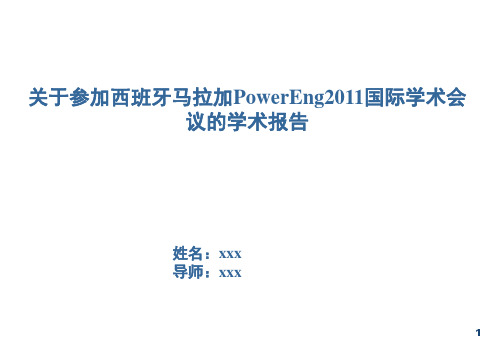
5
会议宗旨 The lemma for the present edition of the conference is “…Integrating Renewables into SmartGrids”. SmartGrids and renewable energies are quickly becoming cornerstones of modern and sustainable power systems. Most likely, they will play a key role in the next decades for highly automated and carbon-free power systems.
11
3.
参会论文 内置式永磁同步电机转子优化设计(Optimal design of the rotor structure for interior permanent magnet synchronous motor )
转子辅助槽
转子轭部挖洞
ቤተ መጻሕፍቲ ባይዱ12
4.
参会论文 新型SVM-DPC控制用于不对称故障下并网变流器控制 (A novel SVM-DPC control method for Grid Connected ACDC Converters under Asymmetrical Fault) 本文提出了应用 于输入电压不平 衡的三相电压源 逆变器中的一种 基于空间矢量调 制的直接功率控 制方法
关于参加西班牙马拉加PowerEng2011国际学术会 议的学术报告
姓名:xxx 导师:xxx
1
会议介绍
参会过程
旅途见闻
2
国际会议论文格式要求
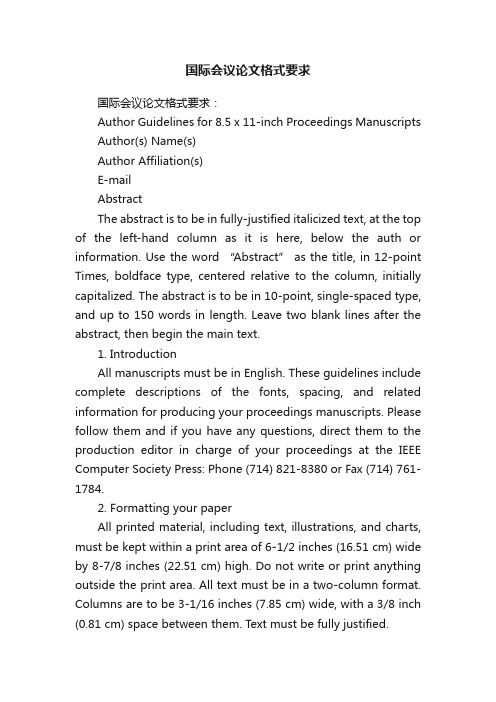
国际会议论文格式要求国际会议论文格式要求:Author Guidelines for 8.5 x 11-inch Proceedings Manuscripts Author(s) Name(s)Author Affiliation(s)E-mailAbstractThe abstract is to be in fully-justified italicized text, at the top of the left-hand column as it is here, below the auth or information. Use the word “Abstract” as the title, in 12-point Times, boldface type, centered relative to the column, initially capitalized. The abstract is to be in 10-point, single-spaced type, and up to 150 words in length. Leave two blank lines after the abstract, then begin the main text.1. IntroductionAll manuscripts must be in English. These guidelines include complete descriptions of the fonts, spacing, and related information for producing your proceedings manuscripts. Please follow them and if you have any questions, direct them to the production editor in charge of your proceedings at the IEEE Computer Society Press: Phone (714) 821-8380 or Fax (714) 761-1784.2. Formatting your paperAll printed material, including text, illustrations, and charts, must be kept within a print area of 6-1/2 inches (16.51 cm) wide by 8-7/8 inches (22.51 cm) high. Do not write or print anything outside the print area. All text must be in a two-column format. Columns are to be 3-1/16 inches (7.85 cm) wide, with a 3/8 inch (0.81 cm) space between them. Text must be fully justified.A format sheet with the margins and placement guides is available as both Word and PDF files as and . It contains lines and boxes showing the margins and print areas. If you hold it and your printed page up to the light, you can easily check your margins to see if your print area fits within the space allowed. 3. Main titleThe main title (on the first page) should begin 1-3/8 inches (3.49 cm) from the top edge of the page, centered, and in Times 14-point, boldface type. Capitalize the first letter of nouns, pronouns, verbs, adjectives, and adverbs; do not capitalize articles, coordinate conjunctions, or prepositions (unless the title begins with such a word). Leave two 12-point blank lines after the title.4. Author name(s) and affiliation(s)Author names and affiliations are to be centered beneath the title and printed in Times 12-point, non-boldface type. Multiple authors may be shown in a two- or three-column format, with their affiliations italicized and centered below their respective names. Include e-mail addresses if possible. Author information should be followed by two 12-point blank lines.5. Second and following pagesThe second and following pages should begin 1.0 inch (2.54 cm) from the top edge. On all pages, the bottom margin should be 1-1/8 inches (2.86 cm) from the bottom edge of the page for 8.5 x 11-inch paper; for A4 paper, approximately 1-5/8 inches (4.13 cm) from the bottom edge of the page.6. Type-style and fontsWherever Times is specified, Times Roman or Times New Roman may be used. If neither is available on your word processor, please use the font closest inappearance to Times. Avoid using bit-mapped fonts if possible. True-Type 1 fonts are preferred.7. Main textType your main text in 10-point Times, single-spaced. Do not use double-spacing. All paragraphs should be indented 1/4 inch (approximately 0.5 cm). Be sure your text is fully justified—that is, flush left and flush right. Please do not place any additional blank lines between paragraphs.Figure and table captions should be 10-point boldface Helvetica (or a similar sans-serif font). Callouts should be 9-point non-boldface Helvetica. Initially capitalize only the first word of each figure caption and table title. Figures and tables must be numbered separately. For example: “Figure 1. Database contexts”, “Table 1. Input data”. Figure captions are to be centered below the figures. Table titles are to be centered above the tables.8. First-order headingsFor example, “1. Introduction”, should be Times 12-point boldface, initially capitalized, flush left, with one blank line before, and one blank line after. Use a period (“.”) after t he heading number, not a colon.8.1. Second-order headingsAs in this heading, they should be Times 11-point boldface, initially capitalized, flush left, with one blank line before, and one after.8.1.1. Third-order headings. Third-order headings, as in this paragraph, are discouraged. However, if you must use them, use 10-point Times, boldface, initially capitalized, flush left, preceded by one blank line, followed by a period and your text on the same line. 9. FootnotesUse footnotes sparingly (or not at all) and place them at the bottom of the column on the page on which they are referenced. Use Times 8-point type, single-spaced. To help your readers, avoid using footnotes altogether and include necessary peripheral observations in the text (within parentheses, if you prefer, as in this sentence).10. ReferencesList and number all bibliographical references in 9-point Times, single-spaced, at the end of your paper. When referenced in the text, enclose the citation number in square brackets, for example [1]. Where appropriate, include the name(s) of editors of referenced books.[1] A.B. Smith, C.D. Jones, and E.F. Roberts, “Article Title”, Journal, Publisher, Location, Date, pp. 1-10.[2] Jones, C.D., A.B. Smith, and E.F. Roberts, Book Title, Publisher, Location, Date.11. Copyright forms and reprint ordersYou must include your fully-completed, signed IEEE copyright release form when you submit your paper. We must have this form before your paper can be published in the proceedings. The copyright form is available as a Word file, , as a PDF version, , and as a text file in .Reprints may be ordered using the form provided as or .。
国际会议格式说明.

国际会议论文排版及格式要求论文构成及顺序:Title (题目→ Authors (作者→ Affiliations (单位→ Abstract (摘要→ Keywords (关键词→ Text (正文→ Acknowledgement (致谢→ References (参考文献排版软件:Word 2000以上版本纸型:A4 方向:纵向页面设置:页边距:上 2厘米,下 2厘米,左 2厘米,右 2厘米,页眉 1.5厘米,页脚1.75厘米文档网格:选中“只指定行网格” ,每页 46行,跨度 15.6磅,栏数:1,应用于:整篇文档整篇文档段落设置:间距:段前 0行,段后 0行行距:固定值, 12磅(题目行、公式行用单倍行距选中“如果定义了文档网格,则自动调整右缩进”和“如果定义了文档网格,则与网格对齐”单位与摘要间、关键词与正文间、正文与参考文献间空 1行图、表前后空一行各级标题前后不空行字符间距设置:缩放:100%间距:标准位置:标准选中“调整字体的字间距” :1 选中“如果定义了文档网格,则对齐网格”字体和字号:题目:Times New Roman字体,四号,居中,加粗,所有实词首字母大写作者:Times New Roman字体,五号,居中,姓所有字母大写,名首字母大写作者单位:Times New Roman字体, 小五号, 不同单位间用分号分隔, 居中, 要标明二级单位 (大学:院系; 研究院所:处、室等 , 居中,多单位在作者右上角标阿拉伯数字区分摘要和关键词:Times New Roman字体,六号;关键词间用分号分隔;关键词首字母小写,关键词 3~8个一级标题:五号, Times New Roman字体,加粗,所有实词首字母大写;靠左顶格二级标题:小五号, Times New Roman字体,加粗,所有实词首字母大写;靠左顶格三级标题:小五号, Times New Roman字体,第一个词首字母大写;靠左顶格正文部分:小五号, Times New Roman字体;希腊字母用 Symbol 字体图题、表题:小五号,加粗, Times New Roman字体;第一个词首字母大写;图序、表序用 Fig.1、 Table 1图、表中文字用小 5号 Times New Roman字体,量与单位之间用“ /”间隔图注与说明、表注与说明:小五号 Times New Roman字体参考文献:Times New Roman字体,六号图格式:1图序与图题间空 2格,其间不用任何点号。
英语的会议汇报作文格式
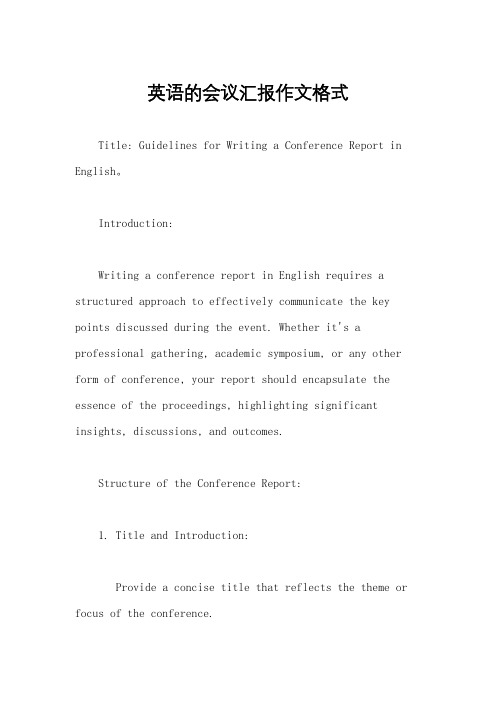
英语的会议汇报作文格式Title: Guidelines for Writing a Conference Report in English。
Introduction:Writing a conference report in English requires a structured approach to effectively communicate the key points discussed during the event. Whether it's a professional gathering, academic symposium, or any other form of conference, your report should encapsulate the essence of the proceedings, highlighting significant insights, discussions, and outcomes.Structure of the Conference Report:1. Title and Introduction:Provide a concise title that reflects the theme or focus of the conference.Introduce the purpose of the report and briefly outline the topics covered.2. Overview of the Conference:Begin with an overview of the conference, including its date, location, and primary objectives.Mention the organizers, sponsors, and notable speakers or participants.3. Key Themes and Discussions:Identify the main themes or topics discussed during the conference.Summarize key presentations, workshops, panels, and debates.Highlight any emerging trends, challenges, or innovative ideas discussed.4. Analysis and Reflections:Provide your analysis of the discussions and presentations.Reflect on the significance of the topics covered and their implications.Discuss any controversies, disagreements, or areas of consensus.5. Recommendations and Next Steps:Offer recommendations based on the insights gained from the conference.Suggest possible actions or initiatives to address identified challenges or opportunities.Outline potential avenues for further research or collaboration.6. Conclusion:Summarize the key points discussed in the report.Emphasize the importance of the conference in advancing knowledge or addressing relevant issues.Conclude with a forward-looking statement about the impact of the conference outcomes.7. References:Include a list of references or citations for any sources cited in the report.Follow the appropriate citation style (e.g., APA, MLA) based on the guidelines provided.Tips for Writing a Successful Conference Report:1. Clarity and Conciseness:Use clear and concise language to convey your ideas.Avoid jargon or technical terms that may be unfamiliar to readers.2. Accuracy and Objectivity:Ensure that information presented in the report is accurate and supported by evidence.Maintain objectivity in your analysis and avoid bias or subjective interpretations.3. Structure and Organization:Follow a logical structure with well-defined sections.Use headings and subheadings to guide readers through the report.4. Engagement and Interest:Write in a way that engages the reader and maintains their interest throughout the report.Use examples, anecdotes, or quotes to illustrate key points.5. Proofreading and Editing:Proofread your report carefully to correct any grammatical or typographical errors.Edit for clarity, coherence, and consistency instyle and formatting.Conclusion:Writing a conference report in English requires attention to detail, clarity of expression, and a structured approach to presenting information. By following the guidelines outlined above, you can effectivelycommunicate the highlights and insights of the conference to your target audience. Remember to tailor your report to the specific requirements and expectations of your readers, whether they are colleagues, stakeholders, or the general public.。
英语的会议汇报作文格式
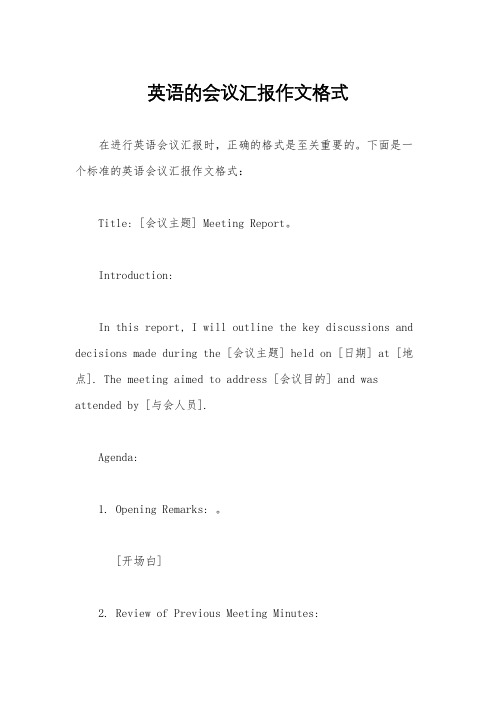
英语的会议汇报作文格式在进行英语会议汇报时,正确的格式是至关重要的。
下面是一个标准的英语会议汇报作文格式:Title: [会议主题] Meeting Report。
Introduction:In this report, I will outline the key discussions and decisions made during the [会议主题] held on [日期] at [地点]. The meeting aimed to address [会议目的] and was attended by [与会人员].Agenda:1. Opening Remarks: 。
[开场白]2. Review of Previous Meeting Minutes:[回顾上次会议记录]3. Presentation of Reports: [报告展示]4. Discussion Points:[讨论议题1][讨论议题2][讨论议题3]5. Decisions Made:[决定1][决定2][决定3]6. Action Items:[行动项1][行动项2][行动项3]Meeting Details:The meeting commenced with [主持人] delivering the opening remarks, emphasizing the importance of [会议主题]. Following this, the previous meeting minutes were reviewed and approved.During the presentation of reports, [报告人] provided an overview of [报告内容], highlighting [重点]. This was followed by a thorough discussion on various topics, including [讨论议题]. Key points raised during the discussion included [关键点].Decisions were reached regarding [决定内容], with consensus achieved on [决定细节]. Action items were assigned to relevant team members to ensure the implementation of the decisions made during the meeting.Conclusion:In conclusion, the [会议主题] was a productive session where important discussions took place and decisions were made to [会议目的]. The action items resulting from the meeting will be diligently pursued to achieve our objectives.Next Steps:The next steps following this meeting include [下一步计划], with a focus on [重点]. It is imperative that all action items are addressed in a timely manner to maintain the momentum generated during the meeting.Closing:I would like to extend my gratitude to all attendeesfor their active participation and valuable contributions to the meeting. Our collective efforts will undoubtedly lead to the successful achievement of our goals.This concludes the report on the [会议主题]. Thank you.Remember to adjust the content to fit the specifics of your meeting, and feel free to add any additional sections or details as necessary.。
学术报告范文模板(推荐9篇)

学术报告范文模板(推荐9篇)(经典版)编制人:__________________审核人:__________________审批人:__________________编制单位:__________________编制时间:____年____月____日序言下载提示:该文档是本店铺精心编制而成的,希望大家下载后,能够帮助大家解决实际问题。
文档下载后可定制修改,请根据实际需要进行调整和使用,谢谢!并且,本店铺为大家提供各种类型的经典范文,如工作总结、工作计划、合同协议、条据文书、策划方案、句子大全、作文大全、诗词歌赋、教案资料、其他范文等等,想了解不同范文格式和写法,敬请关注!Download tips: This document is carefully compiled by this editor. I hope that after you download it, it can help you solve practical problems. The document can be customized and modified after downloading, please adjust and use it according to actual needs, thank you!Moreover, our store provides various types of classic sample essays for everyone, such as work summaries, work plans, contract agreements, doctrinal documents, planning plans, complete sentences, complete compositions, poems, songs, teaching materials, and other sample essays. If you want to learn about different sample formats and writing methods, please stay tuned!学术报告范文模板(推荐9篇)学术报告范文模板第1篇(1)选题依据、课题来源、学术价值和对社会、经济发展和科技进步的意义;(2)文献综述。
国际学术参会总结发言稿

大家好!今天,我很荣幸能在这里代表我们的团队,对本次国际学术会议进行总结发言。
首先,请允许我向组织者表示衷心的感谢,感谢他们为我们提供了一个如此优秀的学术交流平台。
同时,也要感谢各位与会专家和同仁,是你们的积极参与和精彩分享,使得这次会议圆满成功。
本次国际学术会议的主题是“科技创新与可持续发展”,旨在探讨在全球范围内如何实现科技创新与可持续发展的有机结合。
会议期间,我们邀请了来自世界各地的专家学者,围绕这一主题进行了深入研讨和交流。
在此,我将从以下几个方面对本次会议进行总结。
一、会议主题鲜明,内容丰富本次会议紧扣时代脉搏,紧密围绕科技创新与可持续发展这一主题展开。
与会专家和同仁们分别从不同领域、不同角度进行了深入探讨,涵盖了新能源、人工智能、环境保护、可持续发展等多个方面。
会议内容丰富,涵盖了当前国际学术界的前沿问题,为我们提供了丰富的学术资源。
二、学术交流广泛,成果丰硕本次会议吸引了来自全球的专家学者、学者和学生,他们来自不同的国家和地区,拥有不同的学术背景和研究方向。
在会议期间,与会代表们积极参与讨论,分享了自己的研究成果和见解。
通过学术交流,我们不仅拓宽了视野,还收获了丰富的学术成果。
1. 学术报告精彩纷呈:会议期间,多位知名专家和学者做了精彩的学术报告,为我们展示了他们在各自领域的最新研究成果。
这些报告不仅具有较高的学术价值,而且对推动科技创新与可持续发展具有重要的指导意义。
2. 学术研讨深入广泛:会议期间,与会代表们围绕多个议题进行了深入研讨。
大家畅所欲言,各抒己见,共同探讨科技创新与可持续发展的实现路径。
这些研讨不仅有助于增进学术界的了解和共识,也为后续研究提供了有益的启示。
3. 学术合作与交流:本次会议为与会代表们提供了广泛的合作与交流机会。
许多代表表示,通过这次会议,他们找到了志同道合的合作伙伴,有望在未来开展更加深入的合作研究。
三、国际视野,促进合作本次会议是一次具有国际视野的学术盛会。
英语作文会议汇报写作格式

英语作文会议汇报写作格式Conference Report Writing Format.Introduction.When writing a conference report, it is essential to provide a clear and concise overview of the event. Begin by introducing the topic or theme of the conference, highlighting its relevance, and outlining the key objectives or aims. This introduction should set the scene and prepare the reader for the detailed content that follows.Conference Background.In the next section, provide a brief background of the conference. Describe the organization or institution that hosted the event, the date and location, and the target audience or participants. You can also mention the significance of the conference in the field or industry itpertains to.Conference Objectives.Explain the main objectives or goals of the conference. This section should outline the reasons why the conference was held and what it aimed to achieve. It could include topics such as knowledge sharing, industry updates, networking opportunities, or the promotion of specific ideas or products.Keynote Speakers and Presentations.Present a summary of the keynote speakers and their presentations. Highlight the key points or takeaways from each talk, emphasizing their relevance to the overall theme of the conference. You can also provide a brief biography of each speaker, highlighting their qualifications or achievements.Conference Discussions and Interactive Sessions.Describe the discussions and interactive sessions that took place during the conference. This could include workshops, panel discussions, or group discussions. Highlight the main points that were discussed and the outcomes or agreements that were reached.Conference Outcomes and Recommendations.In this section, summarize the main outcomes or conclusions of the conference. Identify the key takeaways or insights that were gained from the event. If there were any recommendations or action plans proposed, make sure to include them in this section.Conclusion.Conclude the report by summarizing the overall impact and significance of the conference. Reflect on the key learnings and how they might affect the organization or industry. You can also provide a personal reflection or opinion on the conference and its value.Appendices.If necessary, include appendices at the end of the report. These could include additional information such as a list of participants, contact details for further inquiries, or copies of presentations or handouts given during the conference.Remember to proofread and edit your report for clarity and accuracy. Ensure that the language is professional and appropriate for the intended audience. Finally, adhere to the specified word count or any other formatting requirements that may be applicable.。
学术报告模板撰写学术研究报告
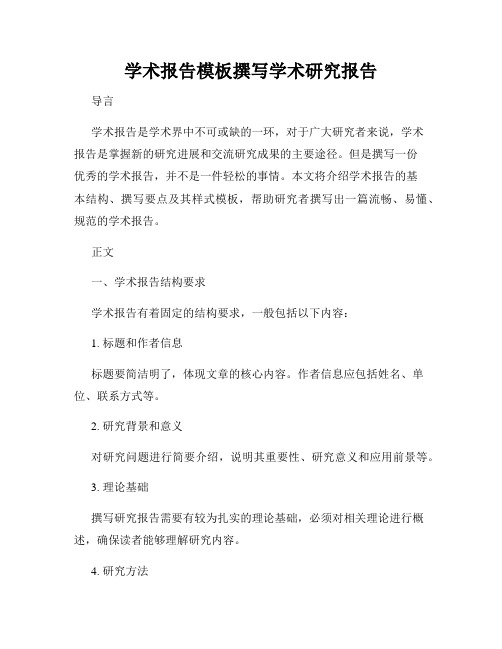
学术报告模板撰写学术研究报告导言学术报告是学术界中不可或缺的一环,对于广大研究者来说,学术报告是掌握新的研究进展和交流研究成果的主要途径。
但是撰写一份优秀的学术报告,并不是一件轻松的事情。
本文将介绍学术报告的基本结构、撰写要点及其样式模板,帮助研究者撰写出一篇流畅、易懂、规范的学术报告。
正文一、学术报告结构要求学术报告有着固定的结构要求,一般包括以下内容:1. 标题和作者信息标题要简洁明了,体现文章的核心内容。
作者信息应包括姓名、单位、联系方式等。
2. 研究背景和意义对研究问题进行简要介绍,说明其重要性、研究意义和应用前景等。
3. 理论基础撰写研究报告需要有较为扎实的理论基础,必须对相关理论进行概述,确保读者能够理解研究内容。
4. 研究方法介绍用于研究问题的基本方法、实验设计、数据收集和分析等。
5. 研究结果对研究的结果和发现进行陈述、总结和分析,应体现研究的创新性和实际价值。
6. 结论依据研究结果,对问题进行分析和总结,提出相应的结论和建议。
二、学术报告撰写要点1. 突出重点,简明扼要研究报告要突出重点,对研究背景、意义、方法、结果和结论等进行简洁明了的描述,以便于读者快速理解。
2. 精益求精,确保撰写质量研究报告需要经过反复推敲、修改和润色,确保其准确、流畅、易懂。
3. 结构精简、层次清晰学术报告应结构精简、层次清晰,必须按照研究报告的基本结构要求进行撰写,以便于读者快速掌握文章主要内容。
4. 表述准确、客观学术报告必须准确表述研究的方法、结果和结论,并注意客观表述,避免主观臆断和情感用词的使用。
5. 图表精美、规范图表必须精美规范,图表的编号和说明应清晰明了,以便于读者快速理解。
三、学术报告撰写样式模板以下为一份范例学术报告样式模板,可按照自己的需要进行修改:标题研究背景和意义理论基础研究方法研究结果结论参考文献注意:参考文献应按照学术界通用的格式进行编写,可查询相关标准进行排版。
结语本文为研究者提供了一份学术报告撰写格式模板,希望能够对大家有所帮助。
- 1、下载文档前请自行甄别文档内容的完整性,平台不提供额外的编辑、内容补充、找答案等附加服务。
- 2、"仅部分预览"的文档,不可在线预览部分如存在完整性等问题,可反馈申请退款(可完整预览的文档不适用该条件!)。
- 3、如文档侵犯您的权益,请联系客服反馈,我们会尽快为您处理(人工客服工作时间:9:00-18:30)。
介绍学术报告结构
• My presentation is structured in the following way • This is how my presentation will go • • • • I will begin with an introduction to … Then I will move on to … After that, I will deal with … And finally, I will conclude with …
文字要求与原则
• 字体大小:标题40号;正文32号,不宜 小于24号 • 文字不宜超过7行 • 字体选择:建议中文用黑体或宋体;英 文用Times New Romans. • 字体颜色:不超过3种,重要文字要凸显
图表使用
文不如表
实验结果 对比结果
文不如表
实验结果 对比结果
3
学术报告的技巧
方程、推导
• Here you can see the derivation process. • Here we are not going to waste our precious time on the lengthy derivation. I would like to invite you to directly take a look at the equation in its final form. • This equation basically tells you
结束语
• Well, this brings us to the end of my presentation. Let us see what we may conclude here. • A promising area of future research is probably … • Okay, this ends my presentation. Thank you for your attention. And I would be really interested in hearing your questions.
考试
• 形式:准备PPT并做学术报告,时间控制 在5-6分钟 • 内容:你的研究或他人的研究,包含背 景、研究内容(要有图或表),时间允 许可包含结论 • 考试顺序按学生名单顺序 • 提前10分钟把PPT拷到电脑中
评分标准
结构内容
清楚程度 仪表仪态 语音语调 时间控制
30%
25% 15% 15% 15%
图的描述
• Here you can see a figure which shows you the relationship between A and B. • This figure shows you how A varies with B. • In this figure, the horizontal axis is A and the vertical axis is B. • In this figure, A is to the horizontal and B is to the vertical. • On the X axis we have A and on the Y axis we have B. • This figure is quite complex, but the only thing I want you to focus on is … • Solid/dashed/dotted/dash-dotted curves • The heavy/thin solid blue line means/represents/is for …
表的描述
• row/column • The key test results are listed/summarized in this table. • The last colument between theoretical predications and experimental results • Basically what I want to highlight in this table is …
Q&A
• Sorry, could you repeat your question more slowly please? • Sorry, could you raise your voice a bit please? • Sorry, I still don’t get your question, would you mind asking me again in the break? • So your question is … • I am not sure if there is a right or wrong answer to your question. Personally, I think …
内容
1
学术报告的结构
2
PPT的准备
3
学术报告的技巧
1
学术报告的结构
学术报告的结构
• 以实验为主的文章
▪ ▪ ▪ ▪ ▪ 题名 内容大纲 试验简介 试验结果及讨论 结论
学术报告的结构
• 以理论分析为主的文章
▪ ▪ ▪ ▪ ▪ 题名 内容大纲 分析方法简介 分析方法的验证 结论
例子
2
PPT的准备
学术报告的技巧
• 通常15-20分钟,平均每30秒一张幻灯片,每张 幻灯片不宜超过1分钟 • 着正装 ,注意仪容 • 自信,不要太在意自己的英文发音(we are not native speakers of English) • 不要始终盯着电脑屏幕,适时环顾四周,避免 读PPT • 不用讲得太细(别人会去看论文),突出重点 • 准备一支激光笔,讲重点时用 • 减缓紧张情绪,语速慢一点 • 练习、练习、再练习
内容转换
• Okay, let me start by looking at … • First, I would like to give you a bit of background. • So why did we conduct this research? Well, … • Now let me move onto … • Okay, now we are going to take a look at the next section.
原则性要求
• 背景(why)
▪ 新 ▪ 重要
• 方法(how)
▪ 无需说的太细 ▪ 重点突出
• 结果和讨论 (what)
▪ 多用图 ▪ 少量说明性文字 ▪ 慎用动画
模板选择
• 通用模板 • 自制模板 • 做学术报告推荐简单明了的幻灯模板 • 模板合适位置标明你的单位
模板的基本要求
• 建议使用白色为底色的模板,文字黑色, 重点文字红色 • 图片颜色不能过于接近底色,有一定对比 度 • 整个幻灯片配色要一致 • 慎用动画
介绍自己
• Thank you, Mr./Ms. Chair. • I am a Master/PhD student from Zhejiang University and I am currently doing some research on … • Then you can say something about Zhejiang University and the city of Hangzhou and show some relevant pictures. • Today, I would like to share with you some of my research progresses on …
